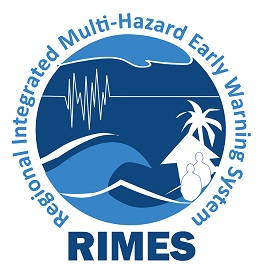Regional Integrated Multi-Hazard Early Warning System for Africa and Asia (RIMES)
1. About RIMES
The Regional Integrated Multi-Hazard Early Warning System for Africa and Asia (RIMES) is an international and intergovernmental institution that is owned and managed by its 48 Member and Collaborating States for building capacities in the generation and application of user-relevant multi- hazard early warning information, for resources and risks management. RIMES was established on 30 April 2009 through the signing by collaborating countries of the RIMES regional cooperation agreement. RIMES was registered with the United Nations under Article 102 of the UN Charter on 1 July 2009. RIMES Headquarters operates from its regional early warning center, located at the campus of the Asian Institute of Technology in Pathumthani, Thailand.
RIMES’ purpose is to provide early warning services according to differing needs and demands of its Member States, for enhanced preparedness and response to, and mitigation of, natural hazards. Its specific objectives are:
- Facilitate the establishment and maintenance of core regional observing and monitoring networks to ensure data availability for early warning;
- Provide earthquake and tsunami services within the framework of the Intergovernmental Oceanographic Commission of the United Nations Educational, Scientific and Cultural Organization (IOC-UNESCO);
- Support National Meteorological and Hydrological Services (NMHSs) for providing localized hydro-meteorological risk information within the framework of the World Meteorological Organization (WMO); and
- Enhance warning response capacities at all levels (national to community) within each national early warning
RIMES provides a portfolio of options for Member States to avail from, or contribute to, any of these objectives.
2. Background
This introductory note is provided to enable you to understand the Tamil Nadu State Disaster Management Authority (TNSDMA), its responsibilities and the administrative set up in which you are expected to integrate yourself for delivering the best of your services and enhance the effectiveness of the Organization.
TNSDMA has many Senior Policy Makers, Senior Administrators with rich experience of leading from the front during disasters and officials who tirelessly work on 24X7 basis, in preparedness, response, relief, reconstruction and mitigation. We value your individual Qualifications, expertise, knowledge and skills, but how you embed yourself in the above ecosystem as a Core team player will be more important to the Organization.
Organization
The Tamil Nadu Disaster Risk Reduction Agency (TNDRRA) is the Executive Agency of the Tamil Nadu State Disaster Management Authority (TNSDMA).
The TNDRRA functions under the overall control of the Commissionerate of Revenue Administration and Disaster Management headed by the Additional Chief Secretary and Commissioner of Revenue Administration/ State Relief Commissioner. The TNDRRA is headed by the Director Disaster Management assisted by the Joint Director (Disaster Management) Assistant Commissioner (Recovery & Reconstruction), Assistant Commissioner (Natural Calamities) and Assistant Commissioner (Documentation and Media Relations)
The functions of TNDRRA are:
- To act as the executive agency for the State Disaster Management Authority for coordinating the various Disaster Management related activities in the State at all
- To guide and assist the District Administration in the rescue and relief
- To act as a resource center for information, trained manpower, experts, NGOs and community-based
- To undertake Capacity building, training and awareness relating to Disaster Management and
- To provide technical assistance and consultancy services to the
- To undertake research and development processes regarding causes for losses on account of natural disasters and to suggest remedial measures for minimizing the
- To develop approach, philosophy, policy guidelines, management and action plans for managing disaster of any
- To formulate and implement externally aided projects on disaster
- To achieve the objects of the Society and to obtain funds for mitigation, risk reduction activities rehabilitation and settlement and to ensure optimum utilization of these funds obtained in the form of grant, aid, assistance or loan from Government of Tamil Nadu, Government of India, World Bank, ADB, USAID, DFID, IFRC, Donors, NGOs and from financial institutions, public and private trusts or any other
- Management, Administration, Investment & Re-investment of funds out of sale proceeds received from the sale of land, buildings, equipment’s, furniture, fixtures, debris or any other things or articles or infrastructure
State Emergency Operation Centre (SEOC)
The SEOC / Control Room is a 24-hour communication Center that disseminates all early warnings and alerts received from Indian Meteorological Department, Central Water Commission, Indian National Centre for Ocean Information Services, and other authorities to state Authorities, District Collectors and with the associated line Departments of State Government. People requiring emergency assistance contact the SEOC by dialing the toll-free number 1070. The SEOC is equipped with modern communication equipment adequate manpower and material resources and it functions in close collaboration with 38 District Emergency Operation Centers, the National Emergency Operations Centre (NEOC) New Delhi, District Collectors, Monitoring Officers other Disaster Warning agencies (National & State), Armed Forces, National Disaster Response Force, Tamil Nadu Disaster Response Force and Tamil Nadu Fire and Rescue Services.
The SEOC has the following Communication and Decision Support Systems.
- Emergency Response Support Services (ERSS) – a system that integrates “Dial 112 – Pan –India Single number” with the SEOC facilitated by the Centre for Development of Advanced Computing –Trivandrum,
- Integrated Common Alerting Protocol for communication of Disaster Alerts and Warnings, facilitated by the Center for Development of Telematics New
- Integrated Flood Warning Systems for Chennai, TNSDMA- National Centre for Coastal Research Chennai collaborative Project
- Real Time Flood Forecasting for Chennai Basins developed by SECON Consultancy Bengaluru as part of the Tamil Nadu Sustainable Urban Development Project
Multi Hazard Early Warning
The State Emergency Operation Centre is being upgraded with Multi Hazard Early Warning capabilities in tune with the Guidelines of the World Meteorological Organization.
Key activities:
- Develop systems and modules utilizing the latest technological advances, building on the existing mechanisms to enable MHEWC to access, analyze and process all required data and information from various sources in the state, country, region and globe for proactive management of disasters in Tamil Nadu
- To provide key domain experts and specialists to be housed at the Technical Cell of MHEWC and gradually build TNSDMA capacity with the skilled domain expertise to manage and sustain MHEWC – Provide necessary training and orientation to deployed officials/ experts at MHEWC for its effective functioning
- Create an integrated solution for comprehensive risk management for all hazards in Tamil Nadu addressing sectoral risk management decision-making for all sectors that are sensitive to weather/ climate and other disasters.
The Conceptual Framework Technical Cell
The Technical Cell will consist of Multi-Disciplinary Technical Expert Services from RIMES (Remote) for enhancing the Multi-Hazard Early Warning Capability.
Technical Expert Services for enhancing the Multi-Hazard Early Warning Capabilities to support proactive management of disaster risks by housing and sustaining, enhanced TNSMART Decision Support. The expertise from various domains viz., Meteorology, Climatology, Coastal Hydrodynamics, Hydrology, Seismology, Oceanography, Information and Communications Technology, Remote Sensing, Geographic Information Systems, Mass Communication, Climate Information Application and Disaster Risk Management will be availed from RIMES based on the need and for a specific period.
The services will be utilized to maintain, operate and sustain emergency operations and guide TNSDMA’s proactive, risk-informed decision-making. The Hazard Risk Vulnerability Analysis and Risk Mapping will also be completed with these expert services. Part of the above services will be availed from RIMES (Remote) experts on a need basis for specific man-days for defined outcomes.
Expert Services at TNDRRA (Technical Cell) for the development of Real-Time Data Acquisition, Decision Support Systems and Applications for Weather Monitoring and other support services
RIMES will position expert services in TNDRRA and provide technical support, and handhold and build the capacity of TNDRRA personnel on Real-Time Data Acquisition, Decision Support Systems and Applications for Weather Monitoring.
The Technical Cell established as an integral part of the MHEWC would support proactive management of disaster risks by housing and sustaining enhanced TNSMART DSS along with a team of relevant professionals with expertise from various domains- Meteorology, Climatology, Coastal Hydrodynamics, Hydrology, Seismology, Oceanography, Information and Communications Technology, Remote Sensing, Geographic Information Systems, Mass Communication, Climate Information Application, and Disaster Risk Management
This Cell would bring operational, research and development support to the State’s disaster management processes and conduct capacity-building activities on all functional tools and emergency operation management. The Cell would also interact with line departments for regular data collection/ integration and work closely with TNSDMA decision-makers to ensure the delivery of warnings and information to the public through the established emergency operation centres. It would utilize the WMO framework and checklists and customize them to the contextual requirements of the State to respond to the needs of the community at risk and their response capabilities built around the four elements of the end-to-end-multi-hazard early warning system
The Technical Cell will maintain, operate, and sustain emergency operations and guide TNSDMA’s proactive, informed decision-making. The Cell would serve as a technical wing of TNSDMA through competent professionals and provide the following services
- Hazard Risk Vulnerability Assessment and Risk Mapping of Floods, Cyclone, Droughts, Landslides, Lightning, Heat Waves, Earthquake Micro Zonation, Sea Water Incursion, River Erosion, Sea Erosion, CBRN and Crop Inundation
- Standard Operating Procedures for SEOC and DEOCs
- Standard Operating Procedures for Various Disaster Emergencies
- Meso – Scale Weather Forecasting using satellite inputs from the Space Application Centre Ahmedabad
- Establishing Real-Time Data Acquisition, Storage, Data Validation and Processing, Analysis, Security and Access Control, Visualization Dissemination, Scalability and Maintenance for Integrating 1400 ARGs, 100 AWS and more than 600 ARG and AWS of Departments
- Integration of SDEM, I-FLOWS in TNSMART
- Customize Impact Based Forecasts
- Capacity Building of DDMAs and Departments
- Provide support linked to the mandated technical agencies, analyzing the observation/ monitoring data from Satellite, Radar, ARG, AWS and other ground-based observation systems, hydrological networks, lightning detection stations, landslide and ground-motion monitoring and detection stations among others; scientific and technical support for hazard, risk, and impact analysis, especially during
This cell within MHEWC/ TNSDMA shall have a beneficial institutional link with the IMD-RIMES Unit (IRU).

Phone: (+662) 516-0120
Website:
http://www.rimes.int/
Address :
Street :
City: Bangkok
Zip Code: 12120
Country: Thailand
Contact Person : Dusadee Moya
Postion : HR
Email : rimeshra@rimes.int
